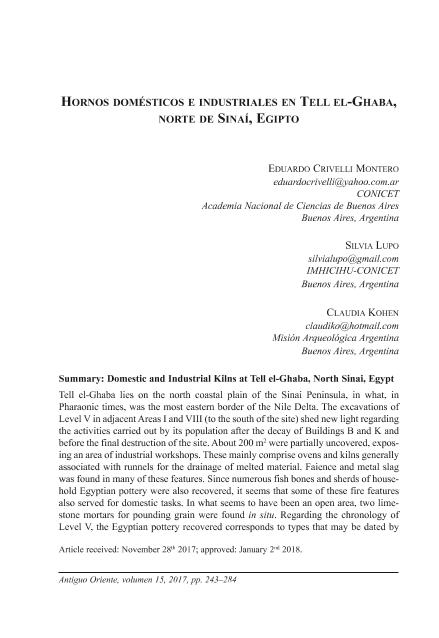Artículo
El sitio Tell el-Ghaba está localizado en la llanura costera del norte de Sinaí en lo que, en tiempos faraónicos, era el extremo oriental del delta del Nilo. Las excavaciones del Nivel V de las áreas adyacentes I y VIII (al sur del sitio) informaron respecto de las actividades llevadas a cabo por la población después del abandono de los edificios B y K y antes de la destrucción final del sitio. Se excavaron unos 200 m2 que expusieron parcialmente un área de talleres industriales, generalmente asociados con canalículos para el drenaje de material fundido. En muchas de estas estructuras se encontró escoria de fayenza y de metal. Ya que se hallaron también numerosos huesos de pescado y tiestos de cerámica doméstica egipcia, es posible que estas estructuras de combustión también hayan servido para actividades domésticas. En lo que parece haber sido un área abierta, se encontraron in situ dos morteros de piedra caliza. En cuanto a la cronología del Nivel V de las Áreas I y VIII, la cerámica egipcia recuperada se corresponde con tipos cerámicos que pueden datarse a fines del Tercer Periodo Intermedio y época saíta temprana. También se hallaron estructuras de combustión en el Área II (al norte del sitio). En el Área II Este, la excavación de dos trincheras expuso hornos domésticos e industriales que pueden haber formado parte de otro taller industrial. En el Área II Oeste, tres estructuras de combustión estuvieron activas durante la erección del Edificio C, aunque cesaron en su función cuando el edificio estuvo ya en uso. Tell el-Ghaba lies on the north coastal plain of the Sinai Peninsula, in what, in Pharaonic times, was the most eastern border of the Nile Delta. The excavations of Level V in adjacent Areas I and VIII (to the south of the site) shed new light regarding the activities carried out by its population after the decay of Buildings B and K and before the final destruction of the site. About 200 m2 were partially uncovered, exposing an area of industrial workshops. These mainly comprise ovens and kilns generally associated with runnels for the drainage of melted material. Faience and metal slag was found in many of these features. Since numerous fish bones and sherds of household Egyptian pottery were also recovered, it seems that some of these fire features also served for domestic tasks. In what seems to have been an open area, two limestone mortars for pounding grain were found in situ. Regarding the chronology of Level V, the Egyptian pottery recovered corresponds to types that may be dated by the end of the Third Intermediate and the early Saite periods. Combustion features were also uncovered in Area II (to the north of the site). In Area II East, the excavation of two trenches exposed ovens and kilns that may have been part of another industrial workshop. In Area II West, three combustion features were active during the erection of Building C, although they ceased to function when the building was already in use.
Hornos domésticos e industriales en Tell el- Ghaba, norte de Sinaí, Egipto
Título:
Domestic and industrial kilms at Tell el-Ghaba, North Sinai, Egypt
Fecha de publicación:
06/2018
Editorial:
Pontificia Universidad Católica Argentina. Facultad de Ciencias Sociales. Departamento de Historia. Centro de Estudios de Historia del Antiguo Oriente
Revista:
Antiguo Oriente
ISSN:
1667-9202
Idioma:
Español
Tipo de recurso:
Artículo publicado
Clasificación temática:
Resumen
Palabras clave:
ARQUEOLOGÍA
,
EGIPTO
,
DELTA NILO
,
HORNOS
Archivos asociados
Licencia
Identificadores
Colecciones
Articulos(SEDE CENTRAL)
Articulos de SEDE CENTRAL
Articulos de SEDE CENTRAL
Citación
Crivelli, Eduardo Adrian; Lupo, Silvia Alicia; Kohen, Claudia Irene; Hornos domésticos e industriales en Tell el- Ghaba, norte de Sinaí, Egipto; Pontificia Universidad Católica Argentina. Facultad de Ciencias Sociales. Departamento de Historia. Centro de Estudios de Historia del Antiguo Oriente; Antiguo Oriente; 15; 6-2018; 243-284
Compartir




